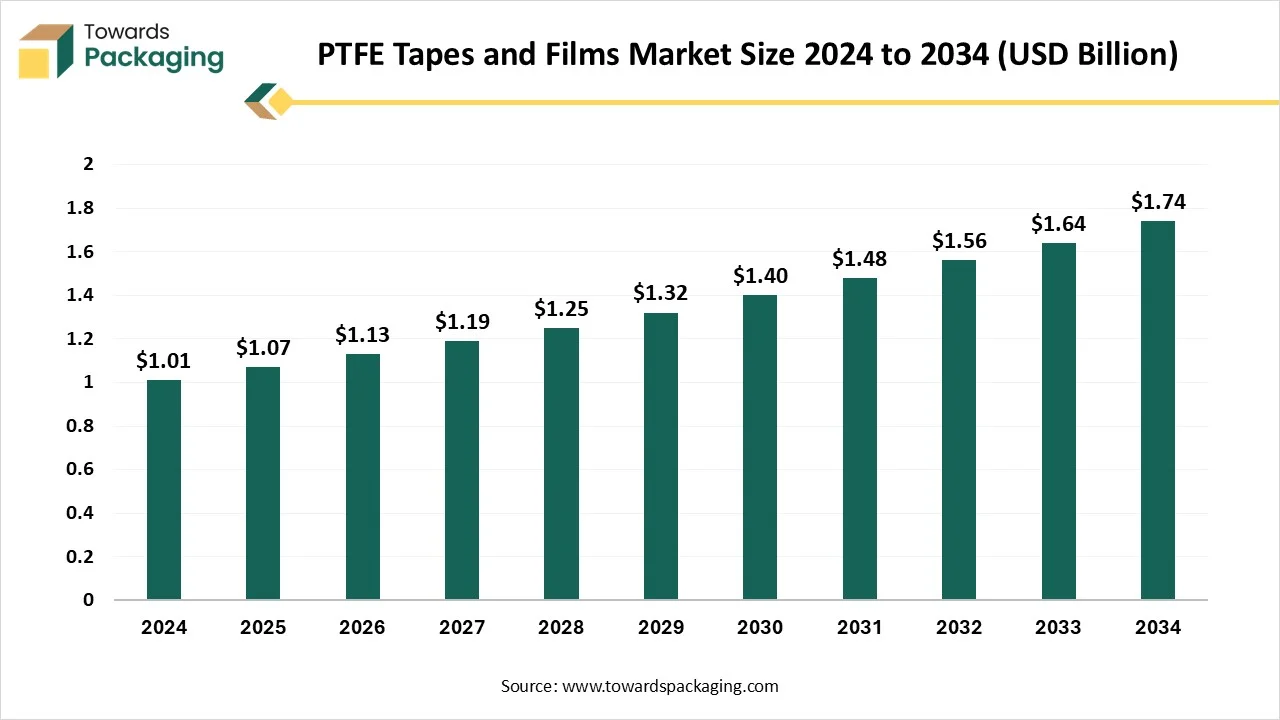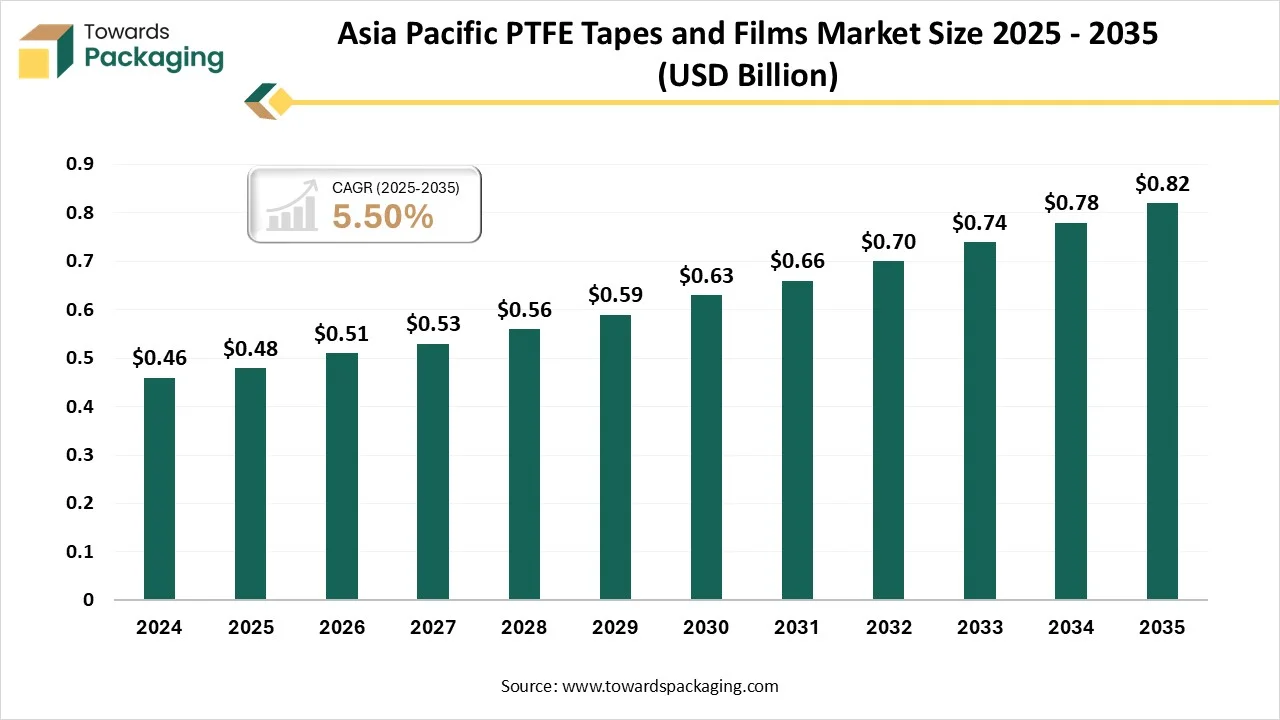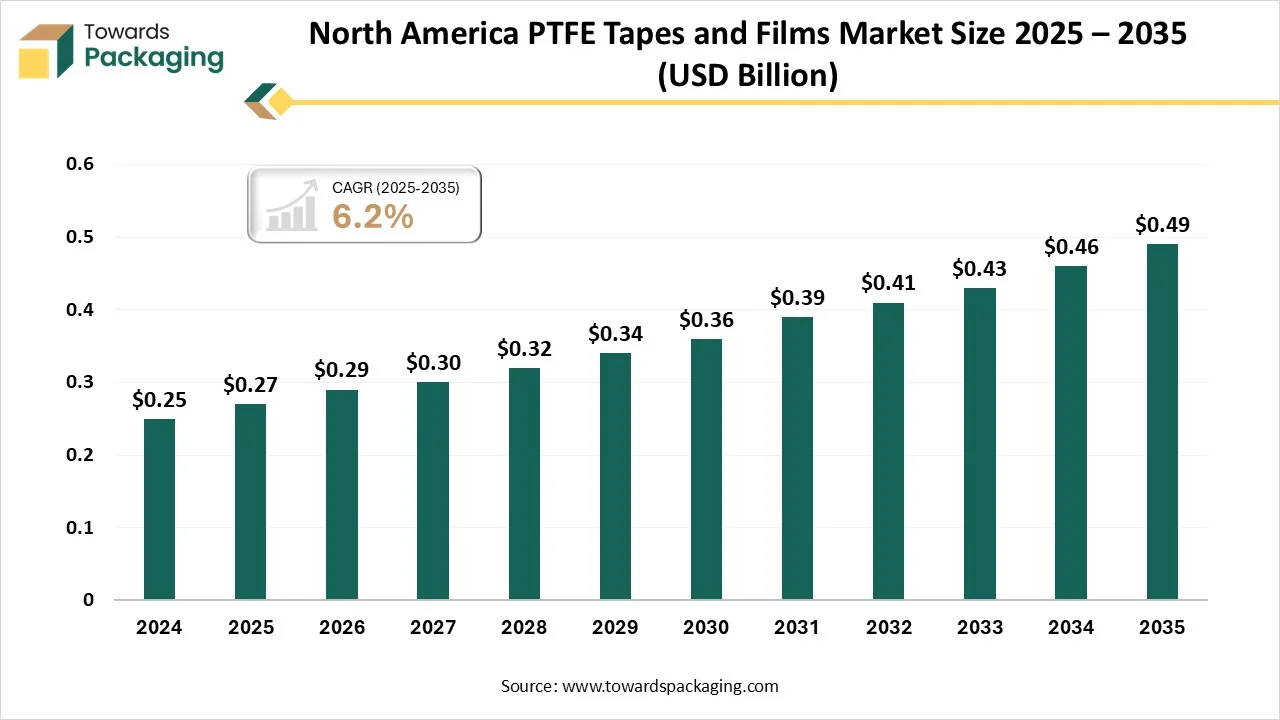December 2025
The PTFE tapes and films market is expected to increase from USD 1.13 billion in 2026 to USD 1.84 billion by 2035, growing at a CAGR of 5.56% throughout the forecast period from 2026 to 2035. This report covers the market's segmentation by product types, including PTFE adhesive tapes (40% share in 2024) and expanded PTFE films, which are expected to experience rapid growth. Key regions such as Asia Pacific, North America, and Europe show significant market activities. The report includes comprehensive competitive analysis, trade data, and manufacturers like 3M, Saint-Gobain, and Nitto Denko, providing insights into key growth areas.

The PTFE (Polytetrafluoroethylene) Tapes and Films Market comprises products used for sealing, insulation, lubrication, and surface protection across industries such as electronics, automotive, aerospace, chemical processing, and construction. Known for their exceptional non-stick properties, high chemical resistance, dielectric strength, and wide temperature tolerance, PTFE tapes and films are widely adopted in applications requiring durability and reliability under extreme operating conditions.
Artificial Intelligence and high-level manufacturing technologies are updating the PTFE tapes and films sector. AI-driven quality control systems now detect micro-defects and optimize production parameters in real time, developing product consistency and reducing waste. Automation and digital twin technology develop accuracy during stretching processes and extrusion, ensuring uniform thickness and strength. At the same time, advancements in surface modification, nanocoatings, and hybrid composites are broadening PTFE’s uses in aerospace, electronics, and medical fields. These inventions are assisting manufacturers to boost efficiency, lower costs, and meet the rising demand for high-performance, sustainable PTFE materials.
The future of PTFE tapes and films lies in intelligent, greener, and more specialised applications. With current R&D in nanocomposites and functional coatings, PTFE is expected to receive greater thermal stability, conductivity, and flexibility. The integration of AI-based manufacturing will allow ultra-precise customization for aerospace, electronics, and medical sectors. Moreover, the encouragement towards sustainability will drive innovations in recyclable and eco-modified PTFE formulations. As industries move towards miniaturization and high-performance materials, PTFE tapes and films will play an important role in next-generation technologies, from flexible electronics to high-level medical devices.
Despite their perfect chemical opposition and durability, PTFE tapes and films face many limitations. They have relatively big manufacturing costs and complicated processing needs and demands, making large-scale manufacturing expensive. PTFE’s lower surface energy also limits adhesion to other materials, requiring additional surface treatments. Environmental issues over fluoropolymer waste and non-biodegradability pose sustainability challenges. Additionally, PTFE has limited mechanical power at high temperatures and can deform under heavy load, restricting its usage in certain structural applications.
The PTFE adhesive tapes segment has dominated the market with a 40% share in 2024, as polytetrafluorethylene ( PTFE) is an increasingly specialised polymer and high-performance material with unique and anti-stick properties and temperature resistance. It is a go-to product for uses within the chemical, industrial, electrical, aerospace, or automotive industries that need high-temperature durability and stability. It is linked with a silicone adhesive machine; every PTFE tape is comfortable, has high tensile strength, and great chemical resistance. They are perfect for uses that have high exposure to chemicals, solvents, and acids. PTFE can develop manufacturing capabilities in a variety of uses, such as within cable and wire insulation, as well as electrical insulation.
The expanded PTFE films segment is expected to grow at the fastest CAGR during the forecast period. The expanded PTFE films are microporous, lightweight materials which is made by expanding standard PTFE to create a network of micro-fibrils and nodes. This serves them excellent chemical resistance, thermal stability and low friction along with gas and moisture permeability. ePTFE films are greatly sued in filtration systems, medical implants, industrial gaskets and seals and protective barriers, offering an integration of the breathability, durability and flexibility that standards PTFE films cannot serve with. Their versatility and performance make them increasingly popular in industrial, medical and high-tech applications.
The 0.05mm -0.10mm segment dominated the PTFE tapes and films market with a 35% share in 2024, as they are ultra-thin but durable solutions, greatly used for insulation, surface protection, and sealing too. Their thin profile enables flexible packaging, tight sealing in small gaps, and easy application in electronics, industrial machinery, and aerospace, too. Despite their reduced thickness, they retain PTFE’s chemical resistance, thermal stability, and low-friction properties, making them perfect for applications needing precision, lightweight materials, and reliable performance in challenging surroundings.
The below 0.05mm segment are predicted to be the fastest to rise at the fastest CAGR during the forecast period. PTFE films and tapes having a thickness below 0.05mm are ultra-thin, flexible, and lightweight materials crafted for accurate uses. They are perfect for micro-insulation, delicate surface protection, and high-performance layering in medical devices, electronics, and specialised industrial equipment. Even at such a low thickness, they track PTFE's hallmark chemical resistance, low friction, and thermal stability that allows tier usage in which space is restricted and high-performance material is complicated. Their thickness allows easy conforming to complex shapes and tight gaps without compromising durability.
The electrical insulation and cable wrapping segment has dominated the market with a 30% share in 2024, as it has perfect thermal and electrical insulation characteristics, which make it ideal for applications in the electrical industry. They are utilised to serve electrical insulation, which can use up to 500 volts per mil. It is often used to wrap electrical cables and wires. Furthermore, it is utilised to classify conductive plates in capacitors. The virgin PTFE( polytetrafluoroethylene) film has a wide range of thickness, beginning at 1 mil(0.01) and going up to 10 mil (0.1). Material can be delivered on a sheet, roll, or die-cut to a particular shape. It has the biggest level of electric insulation for any plastic. Hence, it can be used as an insulation spacer or an insulation coating for wire links.
The medical devices and implants segment is expected to grow at a notable CAGR during the forecast period. PTFE tapes and expanded PTFE are greatly used in medical devices and implants because of their chemical inertness, biocompatibility, and low-friction properties. While PTFE tape is utilised for temporary uses like sealing in dental restorations, the PTFE material is frequently used for permanent surgical patches and implants. PTFE and ePTFE are utilised to make synthetic grafts for bypass surgery and repairing damaged blood vessels. Also, PTFE is utilised in the production of artificial heart valves, and to wrap stents used in the coronary artery process.
The electronics and electricals segment dominated the market with a 32% share in 2024, as acetate cloth tapes are utilised only for medium applications, since they cannot go beyond 120 degrees Celsius, 9248 degrees Fahrenheit. Among the main types of electrical tapes, cloth tape is usually less linked with strong dielectric properties, meaning it’s not the perfect choice for uses in which the application is the main factor. Hence, it is prized for its mechanical properties. Acetate silk cloth electrical tapes are ideal, hand-tearable, and flexible too, which is perfect for varnish impregnation. It is due to the potential to oppose chemicals that PTFE tape is prevalently used in electrical applications as insulation or for wrapping wires.
The healthcare and medical sectors segment are expected to grow at a notable rate during the forecast period. They are utilised in medical technologies due to their integration of different characteristics, including but not restricted to heat resistance, chemical resistance, lubricity, durability, rigidity, and low friction coefficient. They are utilised in a huge range of medical devices like pacemakers, catheters, and wire coatings in radiological machinery, surgical sutures, ophthalmic products like contact lenses, medical tapes and wound dressings, medical device packaging, and blood bags too.

Asia Pacific dominated the PTFE tapes and films market with 45% share in 2024 as the demand for PTFE tapes and films is growing rapidly, which is being driven by stretching electronics, automotive, chemical processing, and industrial sectors. Countries like India, China, Japan, and South Korea are on top due to technological adoption, industrialization, and supportive government policies. The region favors high-performance, durable PTFE materials for sealing, insulation, and protective applications, and growth is further fueled by growing manufacturing capacities and inventions in manufacturing technology.
China PTFE Tapes And Films Market
The market for PTFE tapes and films in China is witnessing robust growth, anchored by rapid industrialisation in sectors like electronics, automotive and chemical-processing. Key drivers include expansion of infrastructure, build-out of electric vehicles and large electronics manufacturing base requiring high-performance insulation and sealing materials.

North America is expected to be the fastest-growing in the market during the forecast period. This region has a rigid and constant demand for PTFE tapes and films, driven by high acceptance in automotive, electronics, aerospace, and medical industries. Canada and the U.S. are top markets due to high-level manufacturing infrastructure, rigorous quality standards, and current invention in high-performance materials. Growth is fueled by the demand for chemically resistant, low-friction materials and heat-stable materials in uses like sealing, insulation, and protective layers. Increasing industrial automation and technological upgrades in manufacturing processes are further assisting in the region's market expansion, while tailored PTFE solutions for specialized applications are becoming more prevalent.
United States PTFE Tapes And Films Market
The U.S. market for Polytetrafluoroethylene (PTFE) tapes and films is experiencing steady growth, driven primarily by demand in high-performance sectors such as electronics, automotive (including EVs), aerospace and chemical processing. Key growth factors include stricter performance and safety requirements in industrial applications and increasing use of PTFE for insulation, sealing and protective layers in electronics and infrastructure.
Europe expects the notable growth in the market during the forecast period. Europe displays constant growth, driven by its rigid industrial base and a concentration on sustainability and high-level manufacturing. Strict environmental regulations, specifically the European Green Deal, are pushing investments in eco-friendly PTFE alterations and procedures. The UK and Germany are the main players, with investments focused on high-performance materials and aligning with regulatory requirements.
Germany PTFE Tapes And Films Market
The market for Polytetrafluoroethylene (PTFE) tapes and films in Germany is growing modestly, reflecting the country’s mature industrial landscape. This steady growth is largely driven by the automotive, machinery and electronics sectors, where demand for PTFE’s high-temperature, low-friction and chemical-resistant properties remains strong.
By Product Type
By Thickness
By Application
By End-Use Industry
By Region
December 2025
December 2025
December 2025
November 2025